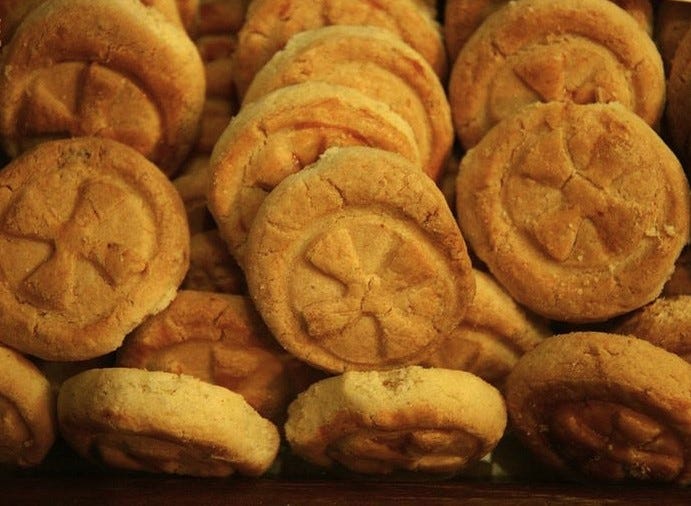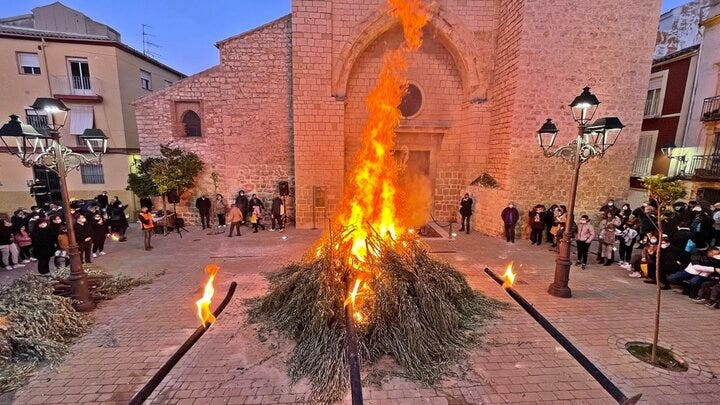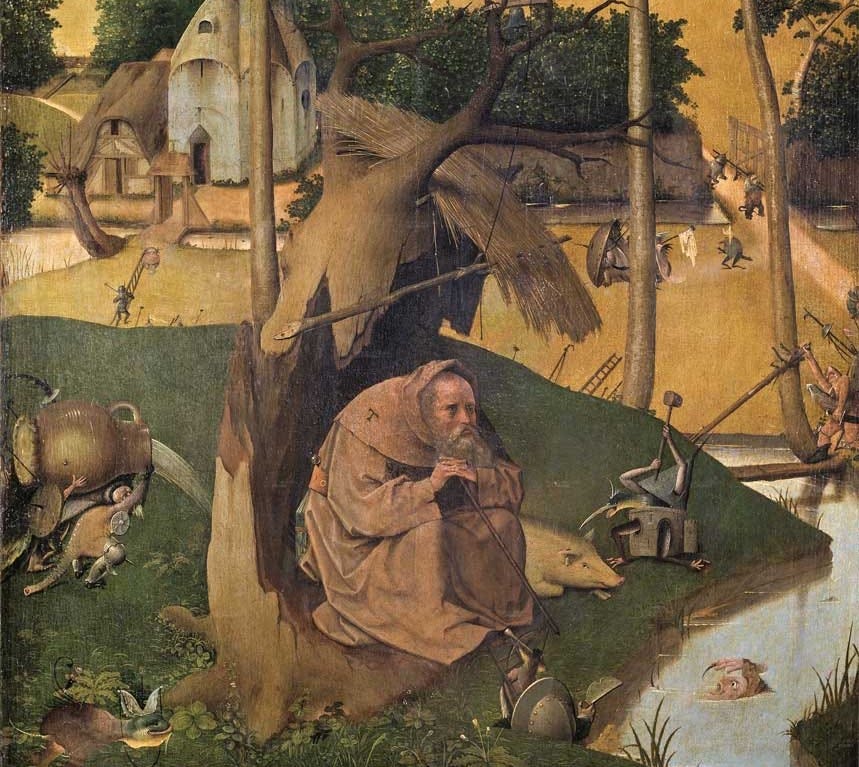The Panecillos of San Anton
How the story of Saint Anthony and the Devil's temptations became a day of blessing our animals and enjoying anise biscuits.

When I was a student at a Catholic highschool, I embarrassed myself at Mass one day by deciding to participate in the Eucharist. When I held the wafer in my hand, said thank you and began to walk off, the priest called me back and asked if I was Catholic. I shook my head and was told to give the wafer back.
This is a good example of my limited knowledge of the Catholic Church before I went to Spain.
I had no idea who the pantheon of saints that adorned every church and cathedral were and even less what the symbols and emblems they were depicted with meant. But I later found the stories associated with every saint fascinating, especially the methods of their martyrdom, for example Catherine and her spikey wheel, Laurence and his grill, Sebastian pin cushioned with arrows, or Lucy and her eyeballs.
Then there were the saints who are more benignly portrayed for their role in Christianity, such as Peter and his keys, or John the Baptist and his lamb. But, of course, they were far less interesting.
I was also struck by how much the saints played an important part of many Spaniards’ daily lives. Saints are celebrated on their feast days (usually the day they died) which is the best time to ask a saint to intercede on your behalf, and to grant blessings and protection. Some people have a particular connection to a saint for personal reasons and show their devotion by wearing images of the saint, collecting relics, offering candles or flowers at the shrine, participating in pilgrimages, praying, or by preparing food in honour of the saint.
The first time I learned about Saint Anthony was after witnessing a long line of people and their assortment of pets outside a church in Madrid. Was it ‘take your pet to church day’? Turns out it was, because Saint Anthony the Great - also known as Anthony of the Desert, the Hermit, and Father of all Monks whose saint’s day is January 17th - is the patron saint of skin diseases, pig herders, and animals.
The pet owners were at the church to have their dogs, cats, birds, fish, turtles, rodents, and a number of other bewildered creatures blessed by the priests who tossed holy water over them with an aspergillum (yes, I looked that word up). Rather than have the animals parade through the church, the priests sit at the entrance and bless them as they pass by. Cheaper than the vet, for sure.
Saint Anthony is credited for assisting in a number of miraculous healings, especially ergotism, a common infliction in the 4th century caused by rye and other cereals infected with a fungus that produces convulsions, itching, psychosis, vomiting, even gangrene. It became known as Saint Anthony’s Fire in the Middle Ages after the success the monks of the Order of Saint Anthony had at treating it.
But the saint’s connection to animals is said to originate from him having supposedly cured a wild boar of its blindness and by having only animals as companions during his retreat to the deserts of Egypt. It is in the desert where he combats the Devil’s temptations who appears in the guise of wild beasts, voluptuous women, and a monk offering him bread and biscuits while he fasts.
Which brings us to the mouth-watering temptation of panecillos, made every year in Castilla y Leon and Madrid in honour of Saint Anthony. Many saints have a particular food associated with them; Saint James’ almond cake, Saint Joseph’s donuts, or the candied egg yolks of Saint Teresa. For Saint Anthony, it’s anise biscuits, invented in 1810 by a sweet shop in Real de la Almudena Street in Madrid.
Traditionally, the bakeries and households that make Saint Anthony’s panecillos begin the production after Reyes, the Three Kings Holiday on the 6th January. The anise biscuits often resemble pieces of bread or small rolls and are stamped with the cross of Saint Anthony. Being quite dry, it means they will last for many months, which is why it’s important to place a coin under one of them, make a wish and leave it for a year. After the year, throw the coin in the collection dish of your local church (preferably the church of Saint Anthony) to ensure your wish will come true.
In Madrid there is a charity market held in the Plaza de Chueca, between the Church of Saint Anthony and the Market of Saint Anthony, on the 17th January. The animal blessings take place at the church between 10am to 8pm. There is a Mass in the morning, a pet parade at 5.30pm and another Mass at 7pm. After all that, you have a great excuse to go tapas crawling around wonderful Chueca (my old neighbourhood) in the evening and visit the arty boutique shops.

The Fiesta of San Antón is also celebrated in Jaen around bonfires symbolising the flames of Saint Anthony (the ergotism reference). On the evening of the 16th, around twenty bonfires fuelled with the pruned olive branches coinciding with the end of the olive harvest, blaze around the city. Saint Anthony’s connection to pigs means bringing out the chorizo, blood pudding and other pork products to roast on the fires. Popcorn and local wine are passed around and the festive atmosphere lasts till dawn.
Panecillos de San Anton

This recipe turns out less like biscuits and more like small soft rolls. From my research, there doesn’t seem to be a consensus on whether they’re dry biscuits or small rolls. However, this recipe seems to be the one that is more commonly shared.
500g of flour
130g of sugar
125ml olive oil
250ml milk
2 eggs
Lemon zest
Anise aroma
Half a sachet of yeast
Place one whole egg in a bowl and the white of another egg (reserve the yolk), the oil, the sugar and the lemon zest. Mix until the sugar has dissolved.
Add the milk and a few drops of anise aroma and mix thoroughly.
Sift the flour and the baking powder and add little by little to the mixture until a dough is formed that comes off the hands easily.
Shape the rolls by taking portions of dough and forming a ball, then flattening it with the palm of your hand.
Place the rolls on a baking sheet covered with parchment paper, leaving a small space between each roll.
With a knife, draw a cross on each bun and brush with the reserved (beaten) yolk.
Leave to double in size. This can be done by putting the buns in a 50-degree oven (122 F), with a container of water in one corner of the oven.
Once doubled in size, remove the container with water, raise the oven temperature to 200 (390 F) degrees Celsius and leave to cook till golden.
Remove from oven and let cool.
(Recipe adapted from LaRecetaQueBuscas)






I confess to a similar state of ignorance as you begin with! This is a great glimpse into more meaning and practice and reads beautifully
Hi Kristin, thank you for your comment! 😍
Even though it's no longer one of the most religious countries, it's fascinating to see how much the Catholic tradition is still very much part of their cultural identity.